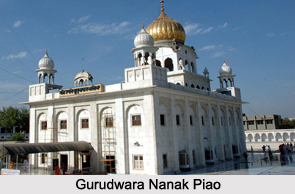 Gurdwara Nanak Piao is a historic Gurdwara located in north Delhi. It is situated on Rana Pratap Road in the Shakti Nagar area of New Delhi. It was built to commemorate Sri Guru Nanak Dev Ji, the first Sikh Guru. The site where the Gurudwara stands today was once a garden where the Guru had camped during his visit to Delhi in 1505, during the reign of Sultan Sikander Shah Lodhi. Consequently, over time Gurdwara Nanak Piao attained a status of a holy and revered historical shrine. Guru Nanak Dev was an apostle of peace, brotherhood, non-violence and amity. His sermons created very uplifting and healthy impact on the people who bowed before him as respect for his spiritual guidance. The garden surrounding the Gurdwara became a place of pilgrimage for the people from all over Delhi. This is where they received the message of spiritual deliverance.
Gurdwara Nanak Piao is a historic Gurdwara located in north Delhi. It is situated on Rana Pratap Road in the Shakti Nagar area of New Delhi. It was built to commemorate Sri Guru Nanak Dev Ji, the first Sikh Guru. The site where the Gurudwara stands today was once a garden where the Guru had camped during his visit to Delhi in 1505, during the reign of Sultan Sikander Shah Lodhi. Consequently, over time Gurdwara Nanak Piao attained a status of a holy and revered historical shrine. Guru Nanak Dev was an apostle of peace, brotherhood, non-violence and amity. His sermons created very uplifting and healthy impact on the people who bowed before him as respect for his spiritual guidance. The garden surrounding the Gurdwara became a place of pilgrimage for the people from all over Delhi. This is where they received the message of spiritual deliverance.
Etymology of Gurudwara Nanak Piao
People who came to visit him, used to shower the Guru and his bard Mardana with numerous gifts, which he distributed among the underprivileged and the poor. In fact, the name of the gurudwara is derived from the habit of Guruji who offered food and water to the hungry and thirsty folk. The well from which Guru Nanak served water to the visitors can still be seen standing inside the complex. The word "Piao" means "to offer liquid to drink" and refers to the offering of water to all the thirsty who visited this shrine.
Legend of Gurudwara Nanak Piao
The curious legend associated with Gurudwara Nanak Piao is, when Guru Nanak came to Delhi, Sultan Sikandar Shah Lodhi came to know of his visit. The Sultan was aware of the news that the Guru had performed the miracle of reviving a dead elephant. So, he asked Guru Nanak to restore one of his dead elephants. However, the Guru refused and as a reprimand, the Sultan ordered his imprisonment. During the time of his captivity, Delhi suffered a massive earthquake on July 3, 1505. It was assumed that ill treatment towards Guru Nanak had caused the catastrophe. Finally, Sikandar Shah Lodhi conceded and ordered the release of the Guru.
Structure of Gurudwara Nanak Piao
Gurudwara Nanak Piao has an impressive Mughal-style gate. The Gurdwara is on a 5 feet high platform and has wide "Pari-Karama". The interiors of the main hall are very well done and part of the ceiling is in "Sheesh Mahal" style. Behind the Gurdwara is a "Sarovar" with beautiful arched veranda on the periphery.
The historic well is still functional and "Amrit" is served by the volunteers. The well is covered with a white dome with pillars decorated in rather bright fashion.
There is a small garden which is in continuance of the garden that existed at that time. There is a separate set of rooms for holding individual "Akhand Paths". On the right side of the main gate are staff quarters which, for the sake of sanctity and beauty of the place, could have been located elsewhere in the premises. There is still lot of area lying vacant. Proper planning of that could greatly enhance the beauty and ambience of the Gurdwara.





















